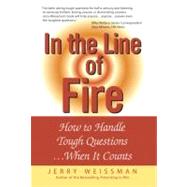
JERRY WEISSMAN, the world's #1 corporate presentations coach, founded and leads Power Presentations, Ltd. in Foster City, CA. His private clients include executives at hundreds of the world's top companies, including Yahoo!, Intel, Cisco Systems, Intuit, Dolby Laboratories, and Microsoft.
Weissman coached Cisco's executives before their immensely successful IPO road show; afterward, the firm's chairman attributed at least two to three dollars of Cisco's offering price to Weissman's work. Since then, he has prepared executives for nearly 500 IPO road shows, helping them raise hundreds of billions of dollars.
Weissman is author of the global bestseller Presenting to Win: The Art of Telling Your Story (Financial Times Prentice Hall, 2003).
In this book, you'll find many examples of Q&A sessions and political debates in the public arena. The original videos of these sessions are available on a DVD that you can obtain by visiting www.powerltd.com .
© Copyright Pearson Education. All rights reserved.
| Introduction: Agility versus Force | xv | ||
|
|||
|
|||
|
|||
|
|||
|
|||
| Chapter One: The Critical Dynamics of Q&A | 1 | (14) | |
|
|||
|
|||
|
|||
| Chapter Two: Effective Management | 15 | (8) | |
|
|||
|
|||
|
|||
|
|||
| Chapter Three: You're Not listening! | 23 | (16) | |
|
|||
| Chapter Four: Active Listening | 39 | (14) | |
|
|||
|
|||
|
|||
|
|||
|
|||
|
|||
|
|||
| Chapter Five: Retake the Floor | 53 | (28) | |
|
|||
|
|||
|
|||
|
|||
|
|||
|
|||
|
|||
|
|||
|
|||
| Chapter Six: Provide the Answer | 81 | (16) | |
|
|||
|
|||
|
|||
|
|||
|
|||
|
|||
|
|||
|
|||
|
|||
|
|||
|
|||
| Chapter Seven: Topspin in Action | 97 | (18) | |
|
|||
|
|||
|
|||
|
|||
|
|||
| Chapter Eight: Preparation | 115 | (10) | |
|
|||
|
|||
|
|||
| Chapter Nine: The Art of War | 125 | (32) | |
|
|||
|
|||
|
|||
|
|||
|
|||
|
|||
|
|||
|
|||
|
|||
| Chapter Ten: The Role Model | 157 | (12) | |
|
|||
|
|||
| Endnotes | 169 | (6) | |
| Acknowledgments | 175 | (4) | |
| Index | 179 |
The New copy of this book will include any supplemental materials advertised. Please check the title of the book to determine if it should include any access cards, study guides, lab manuals, CDs, etc.
The Used, Rental and eBook copies of this book are not guaranteed to include any supplemental materials. Typically, only the book itself is included. This is true even if the title states it includes any access cards, study guides, lab manuals, CDs, etc.